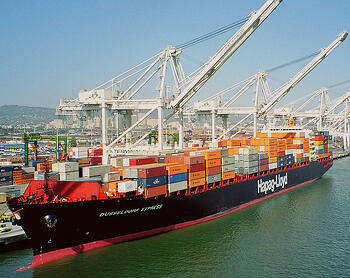Ever Shrinking Carrier Competition – Hapag-Lloyd and CSAV Merging
by Jared Vineyard
It’s not official yet, but it appears the German shipping company Hapag-Lloyd is merging with the Chilean shipping company Compania Sud Americana de Vapores (CSAV).
The two carriers have signed a Memorandum of Understanding (MoA) as they’ve been undergoing talks to merge.
Yesterday, Hapag-Lloyd released the following brief statement on their website:
The talks between Hapag-Lloyd and CSAV about combining the container liner shipping activities of CSAV with Hapag-Lloyd are going into the next phase. Both companies have signed a Memorandum of Understanding (MoU) which is not binding. As the next step, the due diligence will take place, after which a binding contract could follow.
With the signing of the MoA, it’s obvious these two carriers are very serious about merging. Hapag-Lloyd is especially proactive in making this kind of move to increase their size and market share in the wake of all the carrier alliance moves of the P3 Network, G6 Alliance, and CKYH or Green Alliance.
 This isn’t Hapag-Lloyd’s first attempt at such a merger in the recent conditions of the international shipping industry.
This isn’t Hapag-Lloyd’s first attempt at such a merger in the recent conditions of the international shipping industry.
Bloomberg News reported, “Hapag-Lloyd is turning to CSAV after talks to merge with local competitor Hamburg Sued failed in March because shareholders of both companies couldn’t agree on terms.”
I’ve been talking in recent blogs about how unlikely it is that all the carriers shipping out there on international waters right now will be able to stay in business between steep losses carriers sustained recently and the big alliances fighting for control of the shipping lanes.
This is a survival move from Hapag-Lloyd and CSAV. But will it be enough?
First, it’s important to recognize that this is not an alliance like the P3 Network formed by Maersk, MSC, and CMA CGM; this is an actual merger (or will be, supposing it moves forward successfully).
The Wall Street Journal reports, “If successful, the merger will create the world’s fourth-largest container shipper in terms of capacity, with annual revenue of around $13 billion.”
That would put the merged Hapag-Lloyd and CSAV next after each of the three individual carriers of the P3 Network.
Since the P3 Network is not a merger, Maersk, MSC, and CMA CGM should still be competing with each other to book shippers. But then cargo containers from those shippers would be loaded on the container ships from the combined resources of the three largest carriers in the world. Remember, that’s combined ships and combined management of them from the three largest shipping companies in the world.
With the three largest carriers working together like this, many worry smaller carriers won’t be able to compete.
It makes sense that Hapag-Lloyd is working so hard to get bigger. However, even being the fourth largest shipping container company in the world does not guarantee it will be able to compete against the pooled resources of the world’s top three largest carriers, but this is a strong move.
Not only should this move make Hapag-Lloyd/CSAV stronger and in better shape to come out of the Hunger Games of the Sea alive, but as Hapag-Lloyd is part of the G6 Alliance, this move should also give that alliance more strength.
The Wall Street Journal summarizes nicely how the merger is looking to play out in terms of shares and ownership, should you be interested in that sort of thing.
…under current talks, the Luksic family, one of Chile’s richest, and CSAV’s main shareholder, will become a major holder in Hapag-Lloyd with a stake close to that of German billionaire Klaus-Michael Kuehne, who owns 28% of the Hamburg-based shipper, according to a person involved in the deal. The Luksics started buying into CSAV in 2011 and now control 46% of the company.
People involved in the deal said the German company will control around 70% of the merged entity, with CSAV owning the remainder.
We’ll keep you up to date on what’s happening in the world of international shipping here in Universal Cargo Management’s blog. Subscribe by entering your email in the box on the left side of this webpage.
And as always, we’re ready to help you with your import an export needs.
—
Sources:
http://www.hapag-lloyd.com/en/investor_relations/news_page_33583.html
http://online.wsj.com/news/articles/SB10001424052702304632204579337103006408002
![]()
Source: Export

